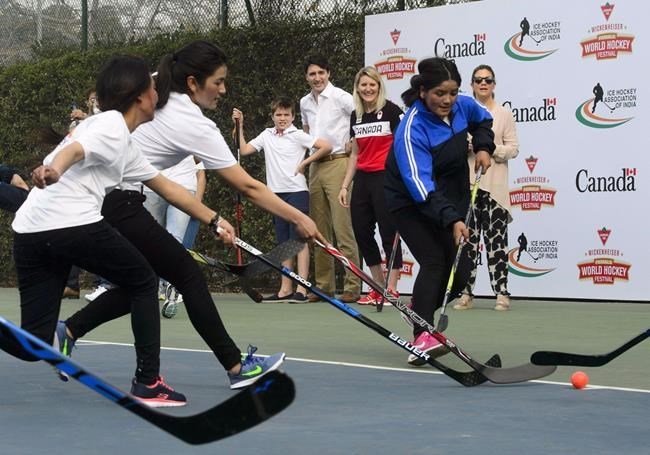
The Liberal government wants to see gender equality in Canadian sports -- from the local hockey rink to the Olympics -- by 2035. Prime Minister Justin Trudeau, wife, Sophie Gregoire Trudeau and son Xavier take part in a hockey event with Hayley Wickenheiser and the Indian women's national ice hockey team at the Canadian High Commission of Canada in New Delhi, India on Saturday, Feb. 24, 2018. THE CANADIAN PRESS/Sean Kilpatrick
Republished February 28, 2018 - 2:35 PM
Original Publication Date February 28, 2018 - 12:26 PM
OTTAWA - The Liberal government wants to see gender equality in Canadian sports — from the local arena to the Olympics — by 2035, a vision articulated in a federal budget aimed at increasing opportunities for women and girls.
The long-term target comes with $30 million over three years to get the ball rolling towards that goal, including for data and research to figure out why fewer women and girls take part in sports or other physical activity than do men and boys.
"Once we better understand why women and girls choose not to participate in sport, or move into the senior ranks of coaching or management of sport, we can then work to remove those barriers," Jocelyn Sweet, a spokeswoman for the Department of Finance, wrote in an email Wednesday.
The budget said the money would also support innovative practices to tackle the problem, as well as efforts by national sports organizations to promote a higher rate of participation of women and girls, both on the ice and behind the bench.
Statistics Canada estimated in 2010 that about one-third of Canadian men regularly participated in sport, compared with just one-sixth of Canadian women.
In a report released last fall, the House of Commons heritage committee recommended setting specific targets for getting more women and girls involved in sport.
Allison Sandmeyer-Graves, CEO of the Canadian Association for the Advancement of Women and Sport and Physical Activity, called the funding a historic step that she suggested could finally provide the momentum necessary to change the numbers in a meaningful way.
"The gap is just so stubborn," said Sandmeyer-Graves, who warned against the conventional belief that it's just the way things are.
"I don't think that we should be satisfied with the fact that girls and women participate and need less than men and are reaping the benefits of sport less than boys and men."
The details remain to be seen, but sports organizations are hoping it means help for their ongoing efforts to achieve a greater balance.
Gord Grace, CEO of Ontario University Athletics, said he would welcome any support for recruiting and retaining more female athletes at a crucial age.
"We know that a lot of females drop out of sports once they get out of high school or above the age of 17," Grace said.
There are about 10,000 student athletes that compete in the system, and less than half are female, he added — a statistic that is partly skewed by the fact that one of the biggest sports is football, which has no teams for women.
Sandra Murray-MacDonell, CEO of the Canadian Collegiate Athletic Association, said her organization offers teams for men and women in all its sports, but is still fighting systemic barriers to getting female athletes into top coaching positions.
The association has a female apprenticeship coaching program that is designed to get graduating college athletes into the coaching profession, she said — but while about 66 per cent do become coaches, they remain in assistant coaching positions or become head coaches at lower-level clubs, she added.
Part of the problem, said Murray-MacDonell, is that the hiring practices at colleges ask for head coach experience, setting up a catch-22 that forces those women to build up their resumes elsewhere.
"We'll have to look at some of those barriers," she said.
Those barriers to girls can crop up right at the community level, added Sandmeyer-Graves.
"In a lot of instances, it's really hard for girls' teams to get spaces to play, because the boys' teams are really grandfathered in," she said, meaning girls have to pay higher prices to get space and time at private recreational facilities.
"That can almost be like a tax on being a girl in the system."
— Follow @smithjoanna on Twitter
News from © The Canadian Press, 2018